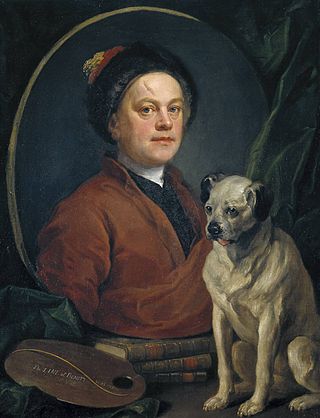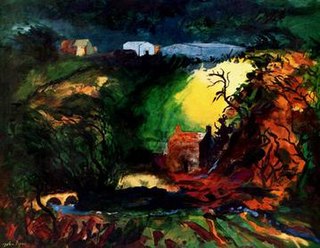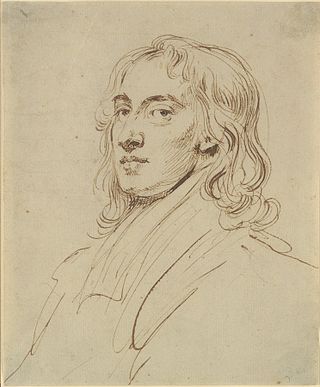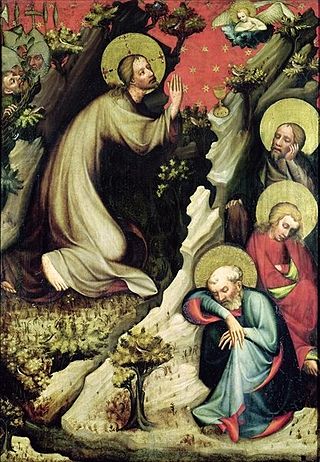
Fra Angelico, OP was a Dominican friar and Italian painter of the Early Renaissance, described by Giorgio Vasari in his Lives of the Artists as having "a rare and perfect talent". He earned his reputation primarily for the series of frescoes he made for his own friary, San Marco, in Florence, then worked in Rome and other cities. All his known work is of religious subjects.

William Hogarth was an English painter, engraver, pictorial satirist, social critic, editorial cartoonist and occasional writer on art. His work ranges from realistic portraiture to comic strip-like series of pictures called "modern moral subjects", and he is perhaps best known for his series A Harlot's Progress, A Rake's Progress and Marriage A-la-Mode. Knowledge of his work is so pervasive that satirical political illustrations in this style are often referred to as "Hogarthian".

Edward Hodges Baily was a prolific British sculptor responsible for numerous public monuments, portrait busts, statues and exhibition pieces as well as works in silver. He carved friezes for both the Marble Arch and Buckingham Palace in London. His numerous statues of public figures include that of Horatio Nelson on top of Nelson's Column and Charles Grey, 2nd Earl Grey on Grey's Monument in Newcastle upon Tyne. Throughout his career Baily was responsible for creating a number of monuments and memorials for British churches and cathedrals, including several in St Paul's Cathedral.

An altarpiece is an artwork such as a painting, sculpture or relief representing a religious subject made for placing at the back of or behind the altar of a Christian church. Though most commonly used for a single work of art such as a painting or sculpture, or a set of them, the word can also be used of the whole ensemble behind an altar, otherwise known as a reredos, including what is often an elaborate frame for the central image or images. Altarpieces were one of the most important products of Christian art especially from the late Middle Ages to the era of the Counter-Reformation.

The Church of St Mary the Virgin, widely known as St Mary Redcliffe, is the main Church of England parish church for the Redcliffe district of the city of Bristol, England. The first reference to a church on the site appears in 1158, with the present building dating from 1185 to 1872. The church is considered one of the country's finest and largest parish churches as well as an outstanding example of English Gothic architecture. The church is so large it is sometimes mistaken for Bristol Cathedral by tourists. The building has Grade I listed status, the highest possible category, by Historic England.

A triptych is a work of art that is divided into three sections, or three carved panels that are hinged together and can be folded shut or displayed open. It is therefore a type of polyptych, the term for all multi-panel works. The middle panel is typically the largest and it is flanked by two smaller related works, although there are triptychs of equal-sized panels. The form can also be used for pendant jewelry.

John Egerton Christmas Piper CH was an English painter, printmaker and designer of stained-glass windows and both opera and theatre sets. His work often focused on the British landscape, especially churches and monuments, and included tapestry designs, book jackets, screen-prints, photography, fabrics and ceramics. He was educated at Epsom College and trained at the Richmond School of Art followed by the Royal College of Art in London. He turned from abstraction early in his career, concentrating on a more naturalistic but distinctive approach, but often worked in several different styles throughout his career.

English art is the body of visual arts made in England. England has Europe's earliest and northernmost ice-age cave art. Prehistoric art in England largely corresponds with art made elsewhere in contemporary Britain, but early medieval Anglo-Saxon art saw the development of a distinctly English style, and English art continued thereafter to have a distinct character. English art made after the formation in 1707 of the Kingdom of Great Britain may be regarded in most respects simultaneously as art of the United Kingdom.

Philip James de Loutherbourg RA, whose name is sometimes given in the French form of Philippe-Jacques, the German form of Philipp Jakob, or with the English-language epithet of the Younger, was a French-born British painter who became known for his large naval works, his elaborate set designs for London theatres, and his invention of a mechanical theatre called the "Eidophusikon". He also had an interest in faith-healing and the occult, and was a companion of the confidence-trickster Alessandro Cagliostro.

Bristol, the largest city in South West England, has an eclectic combination of architectural styles, ranging from the medieval to 20th century brutalism and beyond. During the mid-19th century, Bristol Byzantine, an architectural style unique to the city, was developed, and several examples have survived.

John Vanderbank was an English painter who enjoyed a high reputation during the last decade of King George I's reign and remained in high fashion in the first decade of King George II's reign. George Vertue's opinion was that only intemperance and extravagance prevented Vanderbank from being the greatest portraitist of his generation, his lifestyle bringing him into repeated financial difficulties and leading to an early death at the age of only 45.

Joos van Cleve was a leading painter active in Antwerp from his arrival there around 1511 until his death in 1540 or 1541. Within Dutch and Flemish Renaissance painting, he combines the traditional techniques of Early Netherlandish painting with influences of more contemporary Renaissance painting styles.

St Nicholas is a church in St Nicholas Street, Bristol, England. The church was bombed in the Second World War and rebuilt in 1974–1975 as a church museum. This museum closed in 2007 and the building was used by the city council as offices; in 2018 the church came back into use as an Anglican place of worship in the Diocese of Bristol.
The St Martin's Lane Academy, a precursor of the Royal Academy, was organised in 1735 by William Hogarth, from the circle of artists and designers who gathered at Slaughter's Coffee House at the upper end of St Martin's Lane, London. The artistic set that introduced the Rococo style to England was centred on "Old Slaughter's" and the drawing-classes at the St. Martin's Lane Academy were inextricably linked in the dissemination of new artistic ideas in England in the reigns of George II and George III.

The Master of the Třeboň Altarpiece was a Bohemian painter active in Prague around 1380–1390. His name is derived from the Třeboň Altarpiece from the church of Saint Eligius at the Augustinian convent of Třeboň. The triptych depicts Christ on the Mount of Olives, The Tomb of Christ, and the Resurrection. It has been dated to around 1380, and is today held at the Convent of St. Agnes branch of the National Gallery in Prague.

A donor portrait or votive portrait is a portrait in a larger painting or other work showing the person who commissioned and paid for the image, or a member of his, or her, family. Donor portrait usually refers to the portrait or portraits of donors alone, as a section of a larger work, whereas votive portrait may often refer to a whole work of art intended as an ex-voto, including for example a Madonna, especially if the donor is very prominent. The terms are not used very consistently by art historians, as Angela Marisol Roberts points out, and may also be used for smaller religious subjects that were probably made to be retained by the commissioner rather than donated to a church.
Isaac Jehner was a painter and engraver who worked in the West Country and London. He changed his name to Jenner in 1806.

Mary le Port Street was an important thoroughfare from an early stage in the development of the settlement of Bristol, England, linking the area around St Peters Church and, later, Bristol Castle with the Saxon core of the town to the west at High Street, Wine Street, Corn Street and Broad Street. It was heavily damaged by aerial bombing in 1940, and was relegated to an unnamed service road and footway in post-war reconstruction of the area.
















